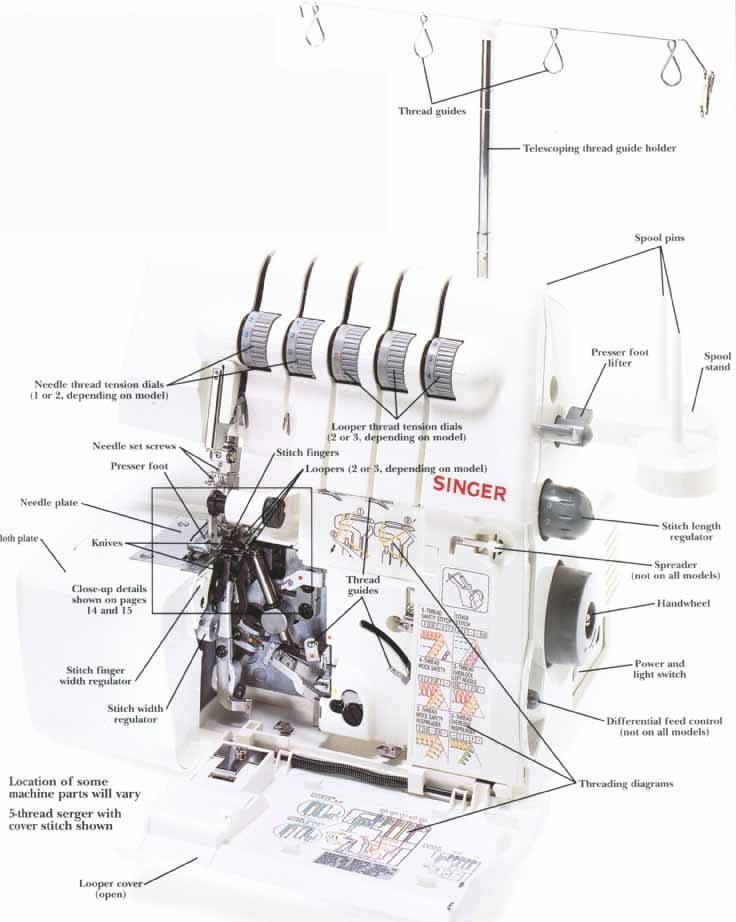A serger is a special-purpose sewing machine that supplements a conventional machine. It is similar to the speed-sewing equipment used by garment manufacturers. A serger cuts sewing time consider— ably, because it trims and overcasts raw fabric edges as it sews the scant. In addition, it performs this three-in-one operation at high speed. Sergers form 1,500 or more stitches a minute -- about twice the rate of conventional sewing machines. As another benefit, all fabrics feed evenly so that even traditionally difficult-to-handle fabrics, such as slippery silks and thin sheers, will not take any extra sewing time.
Because of its unique capabilities, a serger streamlines garment construction. It eliminates time--consuming steps and encourages efficient sewing habits such as flat construction, pinless sewing, and continuous seaming. It also dispenses with routines such as raising and lowering the presser foot, backstitching, and filling bobbins.
Functions and Parts
A serger excels at making self-finished narrow seams, rolled hems, blind-stitched hems, and overcast edge finishes. It is also the machine to choose for applying elastic, ribbing, ribbons, and lace. Use a conventional machine whenever straight or zigzag stitching is necessary such as for topstitching, inserting a tipper, or making buttonholes.
Many different models of sergers are available, each offering different types of stitches. Sergers sew with two, three. four, or five threads. The name of each machine tells which stitches it offers; for example, a 4/3-thread serger can sew either a 4-thread mock safety stitch or a 3-thread overlock stitch. Each stitch type is unique and serves a special purpose.
Needles may he an industrial type with short or long shaft, or a standard type used on a conventional sewing machine. Use the needle specified for your machine. Industrial needles are stronger and last longer than conventional needles, but may be more expensive and less widely available. Change conventional needles frequently. Use the finest needle possible to avoid damaging the fabric. Size 11/80 works for most fabric weights.
Knives work like blades of scissors to trim the fabric for the stitch width selected. One knife is high carbon steel and may last several years. The other knife is less durable and ma require replacement three or four times annually. When knives seem dull, first clean them with alcohol; then reposition and tighten the screw. Test by sewing slowly. If a problem remains, replace the less durable knife and test again. As a last resort, replace the other knife.
Care and Maintenance
Because a serger trims fabric as it sews, it creates more lint than a conventional machine and needs to he cleaned inside and out frequently. Use a lint brush or canned air to clean lint from the looper and throat plate area. wipe off tension discs, needles, knives, and feed dog with alcohol.
To keep a serger running smoothly and quietly, oil it often. Sergers are lubricated by a wick system and can lose oil by gravity even when idle.
Serger Thread
Thread that's fine and strong will perf best. Long-staple polyester (1) is a good, all -- purpose choice; texturized nylon (2 and 2a) has exceptional strength and resilience. cotton and cotton/polyester thread (3) also give satisfactory results but create mole limit and may break with tighter tension adjustments and high speed. Decorative rayon (4), silk (5), and metallic (6) threads can he used for special effects, as can narrow ribbon (7), buttonhole twist (8). pearl cotton (9), and lightweight yarn (10).
Main Parts of a Serger
Many different models of sergers are available, each offering different types of stitches. Sergers sew with two, three, four or five threads. The name of each machine tells which stitches it offers; for example, a 4/3-thread Serger can sew either a 4-thread mock safety stitch or a 3-thread overlock stitch. Each stitch type is unique and serves a special purpose.
A serger can he identified by type at a glance. Each type has a certain number of needles and loopers, and the shape of the loopers is easily recognized.
Click here or image below to enlarge image.




